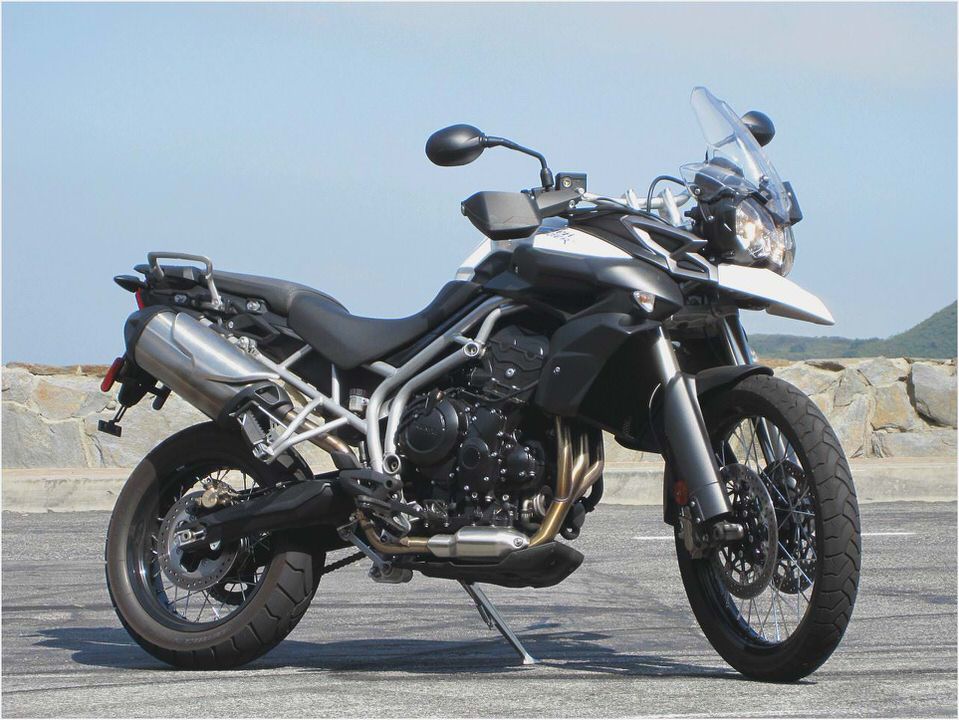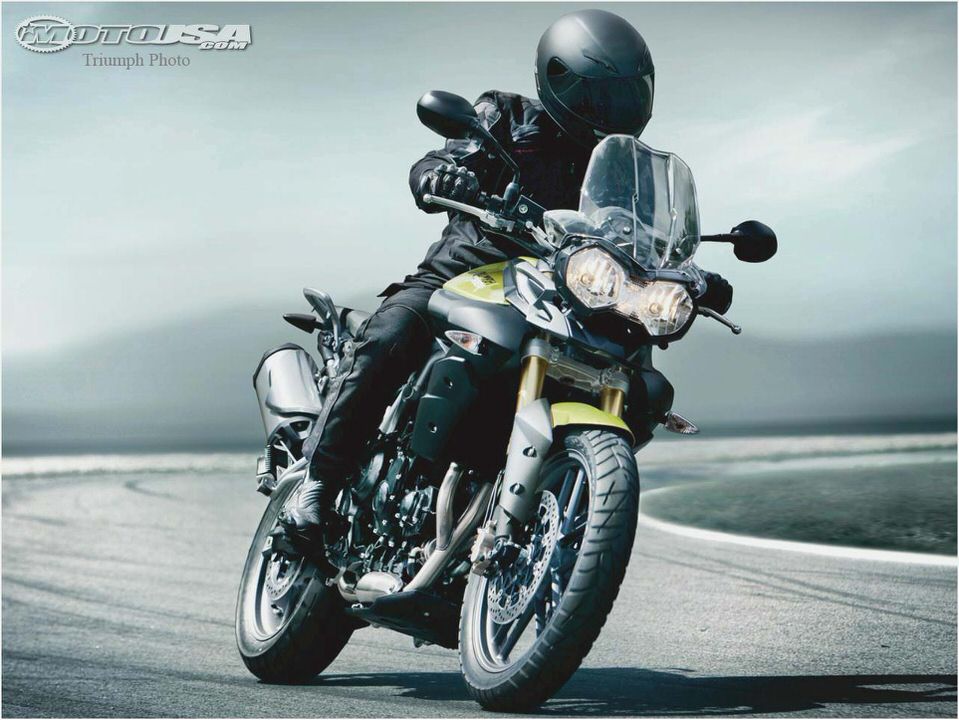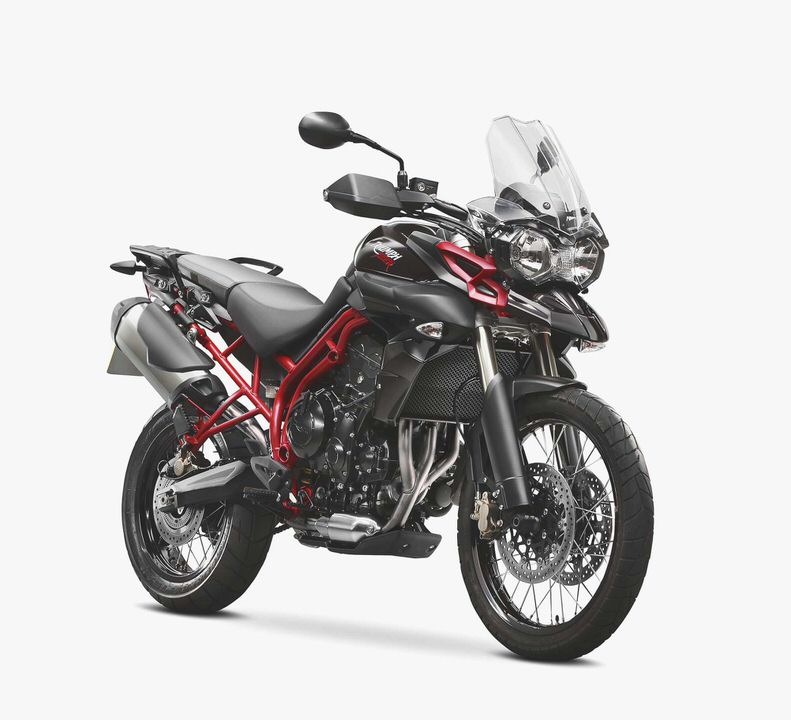
New Motorcycle Review – 2012 Triumph Tiger 800 / 800XC
Tiger Tale – Triple The Fun
Let me take this opportunity to sincerely thank my editor, in print, for respecting my deep admiration for the Triumph Triple motor. When a press invitation came for a two-day, adventure-filled test of the new 800 and 800XC in Southern California, he offered the trip to me.
True, the invite mentioned something about a tent, sleeping bag, and quarters for a shower, but I know Steve was just thinking about giving you, dear reader, the best possible, most thorough test of this fine machine by sending yours truly. I’d tested the Tiger 1050 a couple of years ago, and liked it so much that I completed an Iron Butt challenge on it and shed tears when I had to hand in the keys. So I was pretty excited about trying out its smaller, lighter sibling.
Prior to the press introduction, Steve brought back a brand-new Venom Yellow Tiger 800 from Daytona Bike Week for a long-term test. While he rode it enough for a quick evaluation (June), I’d called dibs on using the bike as my daily commuter for several months before the California press ride, giving me time to learn the nuances of the machine that only someone who lives with it would discover. Riding a bike is one thing; taking care of routine maintenance, gassing up a few dozen times, washing nooks and crannies, and caring for it usually uncovers more information about the motorcycle that otherwise would go unnoticed.
The Tiger 800 (predecessor to Triumph’s new 1215cc Tiger Explorer) is an obvious competitor to BMW’s GS line. And while the 800 aims at the rider who likes a sporty ride with a fair ability to venture off the beaten path, the 800XC model is designed with the occasional off-roader in mind.
Both have wide handlebars and foot pegs that place the rider’s feet directly underneath to offer a sit-up position that’s comfortable for all-day riding and also allows for easy standing and maneuvering. Peg rubbers can be pulled off and stowed under the seat to expose grippy teeth for standing footholds. But the main differences between the two are suspension travel, seat height, wheelbase, and the wheels themselves.
The standard 800 gets street-oriented Pirelli Scorpion Trail tires mounted on cast aluminum, 10-spoke wheels, 19″ in front and 17″ out back. The XC I tested came with Bridgestone Battle Wing rubber on a big 21″ front 36-spoke aluminum wheel and a 17″ 32-spoke out back. The XC offers 40mm more suspension travel in front and 45mm more in back.
Wider bars and taller seat height, along with a 1/2″ longer wheelbase that gives the XC less rake and more trail completes a package that turns a great standard into an off-road capable bike.
The new Tiger’s 799cc, liquid-cooled, 12-valve, in line three-cylinder engine is cradled by an all-new tubular steel trellis frame with a twin-sided cast aluminum swingarm. Styled to appeal to the minimalist who appreciates a utilitarian, versatile adventure bike, painted bodywork is limited to the tank and front fender. The torquey engine falls right in line with all the other Triumph Triples I’ve ridden, offering strong, smooth, immediate power.
It’s responsive to the slightest touch of the throttle, making mid-corner corrections tricky. Even a minor roll-off results in a fair amount of front end dive, upsetting the suspension. I had to really zone in on using silky-smooth throttle movements to maintain a nice suspension. But who’s complaining about having too much power?
Climbing through the six-speed gearbox is easily and swiftly accomplished, and maxing out the Tiger’s 94 horses at 9300 rpm is just plain old fun. Ripping down the road that hot, you may expect the exhaust note to be screaming, but this cat is quiet other than a tinny, hollow sound stemming from detonation in the catalyst. I normally don’t care how my motorcycle sounds, but this particular sound annoyed me.
Triumph offers an Arrow exhaust slip-on for $800 that reduces weight and is said to offer an additional 4 to 5 hp, but also alleviates the annoying detonation sound without adding much volume to the exhaust note itself. (I also rode the Tiger prior to Triumph’s recall notice on the engine management software, which created some engine output glitches at low speeds. I wasn’t the only one who recognized the potential for danger when our Tiger stalled during acceleration after stopping at intersections. Luckily, after the ECU download, the engine ran much smoother, and I didn’t experience any more stalling. Thank goodness for computers.)
Braking on the Tiger 800 is superb, with twin discs up front and single rear disc clamped by dual piston floating calipers on each. ABS is an $800 option and can be switched off, but it’s not easy and can’t be done on the fly like on some of the Tiger’s competitors.
Tiger Tweaking
I spent some time with the XC on Southern California’s twisties and fire roads, and except for a bit more front end dive, mainly in corners, I actually preferred the XC’s tall riding position to the 800’s, which could be considered a little cramped for taller riders. But both versions offer seat height adjustment, with two height-adjustment bars located under the rider’s seat. The bars can be raised or lowered manually with no tools.
One bar adjusts the front seat height, while the other adjusts the rear of the seat. The seat comes off easily by turning the ignition key in the tail section. This pops the passenger pillion off, revealing a small tool kit and some space for gloves or paperwork.
Push the rider seat toward the tank, and it’s removed to reveal the battery and fuse compartment. The owner’s manual gets tucked away in its own spot under the seat pan itself.
Another cool feature to help customize the rider’s ergonomic preference is the Tiger’s risers, which can be turned 180 degrees, setting the bars 18mm farther forward and 8.5mm higher. The brake lever is also reach-adjustable, but the clutch lever is not.
A BMW-style powerport lives on the steering stem, next to the ignition switch. With the Tiger’s 645 watt generator, this comes in pretty handy for powering things like small compressors, heated gear, and handlebar-mounted accessories.
With RoadBike readers in mind, I spent most of my saddle time at the press intro riding an 800 mounted with various forms of luggage. Billed as a bike you can ride anywhere, Triumph is prepared to take you on an adventure with lots of luggage options. The company’s lockable panniers ($800) add significant girth to the Tiger’s form; they are designed to sway with the bike’s lean — like the Sprint GT’s — in order to stabilize the load for best handling.
These bags took quite a beating from some journalists, who ate dirt while riding too aggressively on soft, off-road trails. I saw several sets of bags flung free of their mounts, plastic pieces flying, making remounting the bags impossible without bungees and duct tape. This could be a real problem if you’re out in the middle of nowhere alone. There’s a large, matching top box ($550 with mount kit) that doesn’t increase the bike’s width.

Other Triumph bag options include a large, duffel-style adventure tailpack ($220) with stiff, inner-reinforced material that’s made specifically for the 800, logos included. But mounting your own bag is easy: pair bungee hooks to any number of points on the large luggage rack behind the passenger seat and oversized grab rails. There are also some cool, Tiger-specific tankbags available that allow easy access to the fuel filler area.
In all, there are almost 50 Triumph genuine accessories available for the Tiger 800, and they’re all covered by a two-year warranty.
As mentioned, the press group spent a lot of time traversing Southern California’s dirt, which is certainly not my choice of ground cover. While many of the guys rode ahead, displaying their fortitude for this terrain, I stayed toward the back, working the throttle and brakes slowly and smoothly. Not feeling comfortable with the tires searching for traction and finding none, when there was an opportunity to get back on pavement, I took it, and I wasn’t the only one.
The real fun for me began when we turned to some wonderful roads with fast twisties and drastic changes in elevation. I’d already known that the Tiger’s road handling was fantastic, so I pressed hard and the few of us who chose tarmac over sand were simply flying. The bike’s frame and suspension stayed firm and planted, and gobs of ground clearance meant that we could go as fast as we really wanted to, even in the really tight switchbacks.
The one drawback to the stock Tiger setup is that its small windscreen doesn’t offer much help at speed. The wind buffeting it creates makes the thought of a long, big-mile highway ride unbearable. Taller windshields are available.
Living with the Tiger, I realized that the utilitarian setup suits me just fine. Cleaning it is a bit of a pain because there isn’t much bodywork to cover all the exposed nuts and bolts. Fingers inevitably get sore trying to clean all the recessed areas on the engine and under the frame. Conversely, getting right to the source in order to make repairs is simple because there’s no bodywork to remove first. Oil changes are particularly easy, even without a centerstand.
The Tiger sits up pretty tall, and the stock plastic chin fairing has cutouts that allow the oil to drain cleanly without removing it. Chain adjustments are equally as simple. You only need an axle wrench on one side of the bike to loosen the rear wheel to make the adjustment. Some bikes require a wrench on both sides, which makes for an awkward fight to loosen those nuts.
I found fuel fillings to be a small annoyance. Two small, welded metal bars inside the tank prevent you from damaging the plastic fuel pump with the gas nozzle. Because of this setup, you have to get just the right angle on the nozzle to avoid splatter.
And the filler cap that pivots backward makes it tough to see what you’re doing if you like filling up from the driver’s seat like I do.
Triumph scored high marks with me once again, with the 800 triple proving to be an all-around fun ride. Whether you are into more adventurous expeditions, or just tossing it around your local backroads, the Tiger will get you there with a smile plastered all over your face. RB
By Tricia Szulewski, Photos by Riles Nelson and Tricia Szulewski
Originally published in RoadBike March/April 2012




- Triumph Trophy 900
- Triumph Thunderbird Storm review – Hindustan Times
- Triumph Trophy, 1200cc, 97/98 (R) Bike Review Motorcycles Reviews UKBike.com
- Triumph Thunderbird Storm – Motorcyclist magazine
- News motor bike 2013 with the EICMA: Triumph Daytona 675 (R), blow of…
